Identification FAQs on Loricariids, South and
Central American Suckermouth Cats
Related Articles: Loricariids, Otocinclus, From
Pan-ack-ay to Pan-ack-zee, A Detailed Look at the Bizarre But
Beautiful Panaque Catfishes by Neale
Monks
Related Catfish FAQs: Loricariids 1, Loricariids 2, Otocinclus,
Other Loricariid
Genera: FAQs on: Ancistrus, Baryancistrus, Genera Farlowella, Loricaria, Sturisoma,
Rhineloricaria: Twig Plecostomus, Genera Glyptoperichthys, Liposarcus, Pterygoplichthys, Sailfin Giants
among the Loricariids, The Zebra
Pleco, Hypancistrus zebra, Hypostomus, Peckoltia: Clown
Plecostomus, Lasiancistrus,
Panaque, Pseudacanthicus, Scobanancistrus, L-number
catfish,
Loricariid Behavior, Loricariid Compatibility, Loricariid Selection, Loricariid Systems, Loricariid Feeding, Loricariid Reproduction, Loricariid Disease, Catfish: Identification, Behavior, Compatibility, Selection, Systems, Feeding, Disease, Reproduction, Algae
Eaters,
Mouth parts are often useful for identifying Loricariids to species.
This one stuck on a viewing panel at the Shedd Aquarium 2015
|
%20MD.JPG)
|
|
Bristlenose ID? 12/9/17
Hello:
Just wondering if it is possible to ID a Pleco? There are a bunch of these
"Silver Tipped" Plecos at the LFS
Are these the Common Bristlenose or something with an L#?? I have looked
everywhere to ID them online and some people say they are common Bristlenose
that were line bred. Thank you
<Hi Judy. Identifying Ancistrus species is hard. The standard "Silver-tipped
Bristlenose" is (nominally) Ancistrus dolichopterus, but those usually have
off-white edges to their fins, particularly their dorsal and tail fins. Females
can lack these, of course, but on the male these white edges are usually pretty
obvious. Coupled with the lengthy tentacles
on their heads, male Ancistrus dolichopterus are particularly easy to recognise.
That said, I'm sure there are other wild-caught Ancistrus species out there that
are very similar, and it's probably a safe bet that the name "Ancistrus
dolichopterus" is simply a convention in the hobby for any and all species that
have this basic appearance. Ancistrus hoplogenys for example is very similar
indeed. Let me direct to an excellent article over on PlanetCatfish that covers
the thorny issue of identifying Ancistrus species of this general type, here:
https://www.planetcatfish.com/shanesworld/shanesworld.php?article_id=380
On the other hand, the common generic Ancistrus sold in Britain at least is the
species often referred to as Ancistrus temminckii, though quite possibly
something else entirely, such as Ancistrus cirrhosus. This is the sort that
starts off black-grey with bright white spots, and as it grows becomes more
mottled brown-grey, the spots become less contrasty. This type of Ancistrus
generally lacks the off-white edges to its fins, and so looks a lot like a
scaled-down Common Plec. Your catfish seems closer to the 'Ancistrus temminckii'
sort of Ancistrus than the 'Ancistrus dolichopterus' sort, but that's about as
far as I'd be comfortable going! As I say, identifying Ancistrus is notoriously
difficult, there are literally hundreds of species, including some described
under trade names (i.e., L numbers) but as yet not defined as scientifically
valid species. This is even before you think about the (likely common)
hybridisation in home aquaria, though perhaps less common in the trade, where
fancy varieties of Ancistrus has not really been a thing beyond albino and/or
long-fin forms.
Still, unless the Ancistrus was wild-caught and supplied with a known origin,
I'd rate your chances of identifying a given fish as close to nil, but those
nice folks at PlanetCatfish do have an excellent forum frequented by some first
rate aquarists.
Cheers, Neale>
|
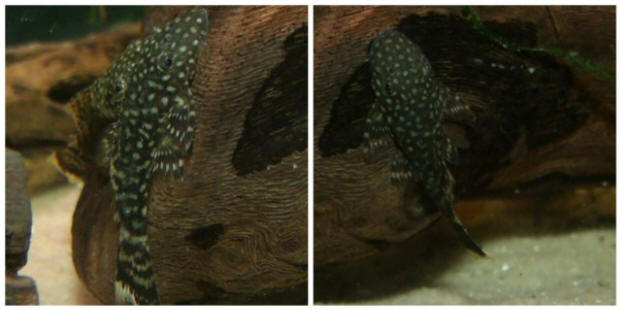 |
L-255 and L-034 medusas, ID - 09/22/17
Hello:
Just wondering if these are the same fish, the L-255 and L-034?? It is proving
hard to find a female black L-034 to mate with the male I have, but I am
wondering about a female L-255. I read that they are bigger than the
L-034, so maybe they are different, I mean they do have different numbers.
I have seen them at the LFS, but the ones there may be common Bushynoses with
spots if there is such a thing, or maybe a female L-255 and a male L-034 would
be a bad idea. There are SO many Pleco types. Thank you
<Hello Judy. Short answer is that the hobby treats them as different fish.
L255 as the "Spotted Medusa Plec" and L034 as the "Medusa Plec". L034 appears to
be the same thing as Ancistrus ranunculus (a lot of these L numbers being
differentiated independently of the scientific process of
naming species) so if we accept that L034 is indeed Ancistrus ranunculus, then
L255 is at worst a closely related Ancistrus from the same bit of the world
(i.e., Rio Xingu) but quite possibly just a geographical variety or
perhaps a subspecies of some sort. The longer answer is that identifying "what
is a species" is extremely difficult at the best of times, and when we're
dealing with what are likely species flocks, then species can easily be
impossible to diagnose on external features like spots and colours alone, and
may require more subtle techniques such as scale counting or even DNA analysis.
So with all that said -- while the two species are likely identical as far as
care go, and interchangeable, I wouldn't keep them together for fear of
cross-breeding. Cheers, Neale.>
re: L-255 and L-034 medusas - 09/22/17
Hello:
<Judy,>
Concerning the crossbreeding. I was reading online about someone who
accidentally bred a green Severum with a blue Acara, and the eggs died out.
<Unsurprising: these cichlids are distantly related; one's a Heros species, the
other an Aequidens. Comparable to trying to crossbreed different genera
in the same family of mammals, say, foxes (Vulpes) with dogs (Canis).>
The person said that they would have to be culled anyway. i had no idea
that if two fish are that closely related, as in the Spotted Medusa and Regular
black Medusa that problems could come up, but I guess they can
<Both members of genus Ancistrus, implying a close relationship, more akin to
donkeys and horses, and possibly even closer than that, like two genetically
distinct but otherwise very similar varieties of horse.>
Maybe they do not interbreed in the wild. Interesting stuff
<Indeed. Rule of thumb is not to combine genera where hybridisation is a
possibility. Often breeding doesn't happen in tanks, so there's no harm mixing,
say, characins or barbs. But Ancistrus can, do breed successfully
in community tanks, so I'd suggest keeping them apart. Cheers, Neale.>
|
Re: Silver dollar swimming upside down and erratically. Not:
Catfish ID 9/3/14
Sorry, me again!
After a few good searches, I can't decide what type of catfish it is I
have....
Am a bit freaked out with some of the descriptions that some of them
grow to 22 inches!!! My tank is one meter long and half a meter high and
wide.....
Thanks, Emily
<My best guess would be a juvenile Pterygoplichthys species, perhaps
Pterygoplichthys joselimaianus. At first I thought Pterygoplichthys
gibbiceps but the markings aren't right. Pterygoplichthys species have
distinctive dorsal fins: one big spine, then 9-11, usually 10, soft rays
behind it. Few of the commonly traded catfish species have so many soft
rays. Do you know the PlanetCatfish site?
http://www.planetcatfish.com/common/species.php?species_id=177
They have a good forum, and if you post a photo there, I'm sure it'll
get
identified pretty quickly. Cheers, Neale.>
|
.jpeg)
.jpeg) |
|
Pleco ID 7/11/13
Hi crew,
Could you please identify this Pleco:
It's about 3". Very active at day time. Ignores any algae wafers so far.
Sucks glass, plants or wood.
Thanks,
Mark
<Hello Mark. Looks like one of what's called a "White Seam Ancistrus" or
"White Seam Bristlenose". More than likely Ancistrus dolichopterus, but
possibly one of the related Ancistrus species. Looks like a male by the
beginnings of "tentacles" around the mouth. Should reach 12 cm/5 inches
or, and like all Ancistrus, is an excellent community fish that consumes
algae
as well as some small invertebrates (e.g., bloodworms). Generally hardy
fish provided water quality is good and temperature is not too high.
There's a nice summary of this group of Ancistrus here:
http://www.planetcatfish.com/shanesworld/shanesworld.php?article_id=380
Cheers, Neale.>
|
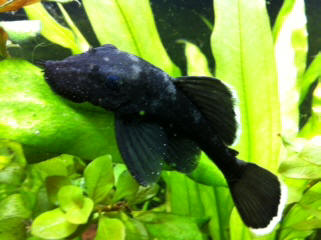 |
Pleco Prize winners
5/31/13
Bob
Prize winners from the Pleco category
<Big Boyz>
Perry |

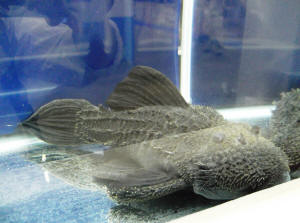 |
|
Re: Help Needed!! Loricariid ID 12/14/12
Here is an Ancistrus from 2 different angles.
My opinion is that this is an Ancistrus Dolichopterus Gold L144a
<Mmm, well; it doesn't look like the Loricariids associated w/ this name I
see on the Net. Neale? BobF>
Best regards
Kostas
Re: Help Needed!! 12/14/12
Here is an Ancistrus from 2 different angles.
My opinion is that this is an Ancistrus Dolichopterus Gold L144a
Best regards
Kostas
<I would (tentatively) concur with Ancistrus dolichopterus but there are
numerous varieties and closely related species. Do try PlanetCatfish.com --
they have a forum and many experts at identifying mystery catfish. Cheers,
Neale.>
|

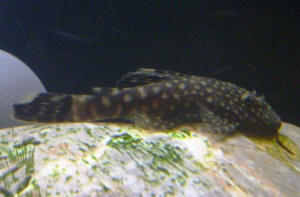 |
|
Identifying Ancistrus 8/28/12
Hello:
I bought a couple of these Plecos, a male and a female (all attached
photos are of them). At the fish store they were named a Trinidad
Ancistrus, I can not find anything about these fish. I was wondering you
would be able to help me in identifying these fish. I was just looking
for the 'L number' and species for them. I have posted on numerous
forums about them, but no
one can identify them for me. I have spent countless hours trying to
match them to pictures of different species online but keep coming up
empty handed. I looked up online for a specialist with the Ancistrus and
your name was the first to come up. Thank you in advance for any and all
help you can give me.
Heather
<Hello Heather. Ancistrus aren't easy to tell apart. Most are brownish
with off-white spots when young, so the look of a specimen doesn't help
much.
Two species spring to mind though. The first is Ancistrus triradiatus,
which has a similar name ("triradiatus") to the word "Trinidad". The
second is Ancistrus trinitatis, a species that is found on the island of
Trinidad.
So far as I know, the second species isn't traded at all, and the first
species only rarely. But my knowledge is of the UK market; the variety
of species in your locale may be different. Cheers, Neale.>
|
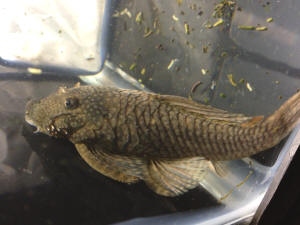
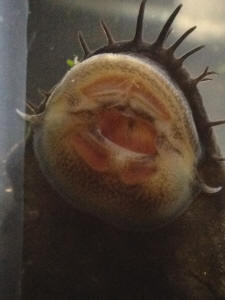 |
Re: Identifying Ancistrus
8/28/12
Neale: Thank you so much for your response. I'm going to look into those two
kinds. Again thank you for your time and the information. I hope you have a
wonderful day!
Heather
<Most welcome. Neale.> |
|
trying to verify if my Pleco is a Trinidad
4/21/10
Hi,
Its been awhile since I wrote in with a question. But today I
have a quick question. I bought a Pleco from a pet store, not a
fish store. The girl at the store said she thinks its a
"Trinidad" Pleco but wasn't sure.
<Indeed.>
I bought him cause I liked how he looked different from the
standard Plecos I have normally seen. I was looking at pics
online but he is small and looks like he "could be" a
different kind.
<Would appear to be a standard issue Ancistrus, what is often
called the "Bristlenose Plec". The photo is really to
blurry to be sure though.
"Trinidad Plec" is a name given to Hypostomus
punctatus. While that species was common enough in the 60s and
70s, I haven't seen it traded much, if at all, in recent
years. Normally the cheap Plecs in most European and North
American pet stores are Pterygoplichthys pardalis and
Pterygoplichthys multiradiatus. When discussing catfish, Latin
names are generally much more useful than trade names, so I'd
encourage you to use these names whilst
searching online for photos of these species.>
I know that pet stores are not always dead on with what they
think the fish they are selling actually is. I was wondering if
you might be able to tell from this pic that I attached if it is
indeed a Trinidad Pleco and is that
the common name or what he might be if that's not what he is.
He is a baby and he is dark brown with light yellow spots and
about an inch long right now.
Thanks
Joe
<Cheers, Neale.>
|
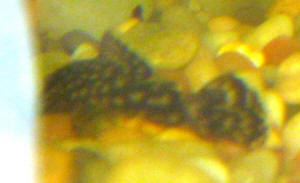 |
Pleco ID - 10/22/2006 Please help! About a week ago I went
into my local fish store to get a Pleco for my 7.5 gallon freshwater
tank. The guy at the store pointed out these cute little algae eaters
that he called butterfly Plecos. He said they would be good for a small
tank because they are a dwarf species. My little fish does not seem to
be very interested in algae so, I went online to do some research. All
of the pictures I found of butterfly Plecos look nothing like my little
guy! Can you please tell me what kind of fish this is so I can take
care of him properly? Thank you so much for your help! Jennifer
<Hard to say from that picture. But it looks like a Peppermint
Pleco. It could also be a female Bristlenose. For a better ID we would
need a good profile shot of him/her flat on the bottom. A raised dorsal
fin would also help. Don>
Re: butterfly Pleco?
Now a Hillstream Loach 10/24/06 > Please help!
About a week ago I went into my local fish store to get a Pleco for my
7.5 gallon freshwater tank. The guy at the store pointed out these cute
little algae eaters that he called butterfly pleco's. He said they
would be good for a small tank because they are a dwarf species. My
little fish does not seem to be very interested in algae so, > I
went online to do some research. All of the pictures I found of
butterfly pleco's look nothing like my little guy! Can you please
tell me what kind of fish this is so I can take care of him properly?
Thank you so much for your help! > Jennifer > <Hard to say
from that picture. But it looks like a Peppermint Pleco. It could also
be a female Bristlenose. For a better ID we would need a good profile
shot of him/her flat on the bottom. A raised dorsal fin would also
help. Don> ...Thank you for your response! I continued looking for
information online yesterday and I came across a page about loaches.
I'm 98% sure that my fish is a spotted Hillstream loach.
<Ahh!> I have him in with two Bala sharks and a dwarf gouramis.
Temp is about 80 which I think might be a little high for him
<Yes> but, I don't want to go to cool for my other fish.
<An example of/for the need to research before purchasing...> I
put an airstone in the tank and added a medium sized rock. Do you think
that will be sufficient for him? (or her) Thank you! Jennifer
<Mmm... Homalopterids need cool, highly oxygenated water... they are
further very often lost due to not being able to compete in tropical
fish aquarium settings. Bob Fenner> Corydoras Breeding and
Pleco Info - 02/16/2006 Hi to all the crew at WWM. Thank you
especially Mr. Bob Fenner for your advice on the swimming behaviour of
my Mochokids. I just have a few other questions please. One of my
bronze Corydoras has deposited about 70 eggs on the aquarium glass,
will they be safe in the community tank or should I transfer them to
the smaller quarantine tank that we have on permanent standby. If so
how do I go about moving them safely? < The eggs are best in their
own tank. Scape them off the glass with a single edged razor blade. Be
sure to use water from the original tank. Add an antifungicide too.>
Also I would like to acquire a lemon spotted green Pleco but am not
sure if my tank is big enough (4ft) as I have heard some Pleco can grow
to approx 18 inches is this the case with the lemon spotted green
Pleco. Thank you. Ann < Go to planetcatfish.com and find the Pleco
you are looking for. Common names sometimes mean different fish in
different parts of the country. This is a great website that can tell
you everything you need to know about your Pleco. The trick will be to
match up the photos with the exact Pleco you have in
mind.-Chuck>
Gold Nugget of Info 9/26/05 Thanks for all the
information you've given me. I would have gone crazy with out you
guys. Ok here's the question. Actually my Pleco is not a common
Pleco. Is it a Gold Nugget Pleco. And they say they get up to only 6
inches not 12 like you said. Could I keep it in a tank with a Green
Terror and a pair of Convicts. (55 Gallon Tank) And could I add a
Snowflake eel to the tank? Thanks a LOT <There are at least two,
maybe three, species of Gold Nugget Pleco. The smaller does max out
around five or six inches. The largest, and most common, can go about a
foot. The problem is they are very hard to tell apart when young.
Collection location is needed to be sure. These plecs are aggressive
towards other bottom fish. No problem with him attacking the cichlids.
But I'm not so sure about housing anything with a pair of Convicts.
They are very aggressive when they spawn. Don>
Un-identified Pleco I have recently gone to my LFS. I saw a
charming little Pleco called a "candy stripe Pleco". I
thought this would be a charming specimen for 30 gallon tank. Though I
have not found any matches for the name and I think the name is false.
Also how big does this fish get, and will he get along with my 3 inch
red tail..... Also I only have those 2 fish in that aquarium. I want to
add Anubias and java ferns and make it a "Amazon tank." I was
wondering what type of Amazonian fish would you recommend for my
aquarium. i.e. Neons tetras, maybe also making this plant heavily
planted...maybe adding a co2 injector for it. please help my set this
aquarium up >> First off, try to check http://www.planetcatfish.com
to see what type of Pleco you have seen. Common names are so varied, it
is better if you find a scientific name or if there is none the
L-number (check that website for the L-number resource, it has tons of
pictures). You write red tail. If you mean shark, yes, no problem. If
you mean red tail catfish it is a problem as he will eat anything he
finds - and eventually your cat. You can make it a planted tank without
too much trouble. The Amazon itself has few plants in it, and Anubias
is from Africa, while Java Ferns are from Indonesia as the name
implies. For those plants you will not need CO2 injection.
Assuming you have a red tail shark you could add larger tetras (*even a
shark may go after Neons), dwarf cichlids and perhaps some Corydoras.
Good Luck, Oliver
Which Plec have I got? Many thanks for your advice regarding
medications. However, I'm now a little confused about the Plec that
I thought I had bought, the Aquarian centre I bought my fish from had
them listed as Ruby Plecostomus, I don't have a picture but he was
around 2" long & a very attractive black leopard type marking
on a rosy gold background. I was informed that he would be quite happy
in a tropical or coldwater tank, providing he was floated to
acclimatize. I can't seem to find any information on the particular
Plec I had if he was a Plec but just wondered if there were any that
were coldwater or have I been misinformed? >> Some Plecos can
handle cooler temperatures, but without knowing what kind of Pleco you
have it is impossible to tell - there are well over 400 species of
Loricariids (commonly called Plecos). Try http://www.planetcatfish.com to
Identify your species. I have never heard the name ruby Pleco. Good
Luck, Oliver
| Emperor/Flash Pleco L204 I Heard that this
is a Emperor L-204 Pleco, I have looked at LiveAquaria.com and I
can 't seem to find this fish. Do you know any other place that
sells them? <L204 is correct, but the common name is the Flash
Pleco. One of the wood eating plecs. Ensure they have an assortment
of natural driftwoods in the tank. There is one for sale on
Aquabid.com right now. Don> <Editor's note: This was
easily found through Google.> |
|
Image removed. Stolen from another site
|
Pleco ID Where can I find out what type of Pleco I have as it
does not seem to match any photos on the net? Can I send you a photo?
<The best site for all info covering Plecos is planetcatfish.com.
I'd be happy to take a look. Don> Thanks Chetna
Bristle Nose Pleco versus Golden Clown Pleco Of the Bristle
Nose Pleco or a Golden Clown Pleco, <There are actually quite
a few of the former and at least two species of the latter. Likely you
have seen our scant presentation on Loricariids:
http://www.wetwebmedia.com/loricariids.htm> 1. Which would be better
at cleaning algae off the sides of the tank? <Probably one of the
Bristlenose Plecos. Please look on Fishbase.org for some idea of which
fishes this appellation applies> 2. Which one would be better at
leaving the plants alone? <The Golden Clowns or some of the smaller
species of Bristlenoses> 3. Which one is most friendly? I have a
community tank with two clown loaches and two Corydoras Julies and will
be getting four Otos. (the other fish are some guppies, mollies, a
tetra and a red swordtail. <Ahh, the Goldens.> Thank you.
<You are welcome my friend. Bob Fenner>
|
|

